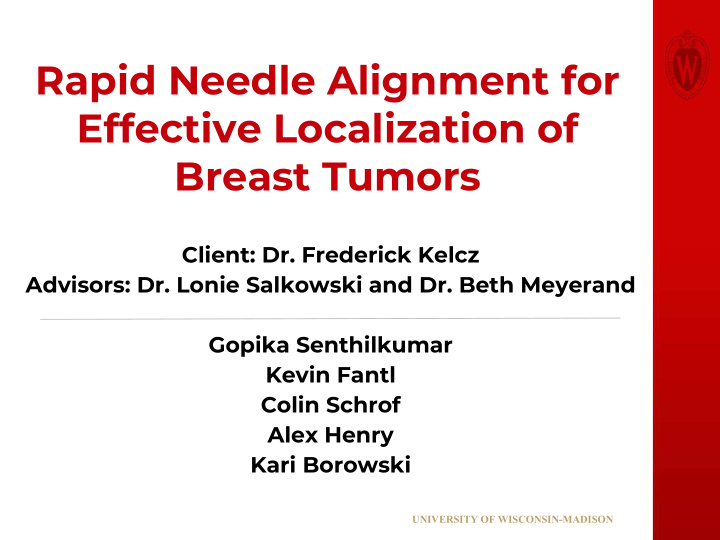



Rapid Needle Alignment for Effective Localization of Breast Tumors Client: Dr. Frederick Kelcz Advisors: Dr. Lonie Salkowski and Dr. Beth Meyerand Gopika Senthilkumar Kevin Fantl Colin Schrof Alex Henry Kari Borowski UNIVERSITY OF WISCONSIN-MADISON
Background - Current Method UNIVERSITY OF WISCONSIN-MADISON
Problem Statement ● Standardize localization technique UNIVERSITY OF WISCONSIN-MADISON
Important Design Constraints ● Clinically effective ● Accurate - Perpendicular approach ● Easy and quick to use ● Safe for patients ● Safe for physicians ● Removable/ Radiotranslucent UNIVERSITY OF WISCONSIN-MADISON
Justification ● Standardization - Quality Control and Save Cost ● Easier to learn procedure ● More comfortable experience for patients ○ Time ○ Reduced radiation ○ Not freehand ● Efficiency ● Technology may be applied in other situations UNIVERSITY OF WISCONSIN-MADISON
Last Semester ● Finalized design of guide ● Designed and validated new Breast Model ● Perfected and practiced study method ● Started IRB approved clinical testing - three subjects ● Started drafting the publication UNIVERSITY OF WISCONSIN-MADISON
Final Design of Guide Countersink Finger Fenestrated Holes Plate Hinge UNIVERSITY OF WISCONSIN-MADISON
New Breast Model Validation UNIVERSITY OF WISCONSIN-MADISON
Study Design: Overview Step 1: Standard localization procedure on model Step 2: Training with needle guide design (30 mins) Step 3: Localization using needle on model Step 4: Post-procedure survey UNIVERSITY OF WISCONSIN-MADISON
Study Design: Participants ● Breast Imaging Fellows ● Physicians ● Residents on Clinical Service ● Any staff authorized to perform localizations UNIVERSITY OF WISCONSIN-MADISON
Testing Goals 1. Validate that our device can accurately guide the needle to its intended location 2. More efficient and standardized than the traditional technique 3. User friendly design. Does it feel comfortable to use? 4. Better for new learners? Other Correlations? UNIVERSITY OF WISCONSIN-MADISON
Final Design Testing Results Top-image Orthogonal-view Top-image Orthogonal-view Free-Hand Localization Localization with Guide UNIVERSITY OF WISCONSIN-MADISON
Clinical Testing Results ● Reduced localization time for ⅔ subjects ● Maintained accuracy *n=3 UNIVERSITY OF WISCONSIN-MADISON
Draft of Publication ● Goal : Introduce a validated, Novel Needle Guide for standardizing and improving the efficiency of Preoperative Wire-Guided Localizations of Breast Lesions ○ Maybe: ■ Easier for new learners ■ correlation with current skill level ● Potential Journal: IEEE Journal of Translational Engineering in Health and Medicine ○ Maybe higher impact - based on results UNIVERSITY OF WISCONSIN-MADISON
Commercialize Semester Goals a t a MAY d e z y l a n A APR Finalize publication MAR and Submit FEB Continue testing UNIVERSITY OF WISCONSIN-MADISON
Data Analysis Plan 1. Difference in time from initial needle puncture to final removal of needle 2. Perpendicular puncture 3. Distance between clip and needle 4. Number of corrections during procedure 5. Other correlations from Survey 6. Statistical Analysis UNIVERSITY OF WISCONSIN-MADISON
Expected Results 1. Procedure with device is faster while maintaining/ improving accuracy 2. Gets perpendicular puncture every time 3. Device is comfortable to use *Other client requirements already met UNIVERSITY OF WISCONSIN-MADISON
Commercialization Details 1. Provisional Patent 2. Find faster, cheaper, more sterile manufacturing method. 3. Each guide packaged in sterile bags - one per patient use. 4. Include pictographic user guide - maybe send representatives to train users 5. Include safety information - for patients and physicians. 6. Approach Hologic with our device. UNIVERSITY OF WISCONSIN-MADISON
Budget Info ● Fall Semester Budget: $200.00 ● Spring Semester Budget: <$100.00 UNIVERSITY OF WISCONSIN-MADISON
Acknowledgements Dr. Lonie Salkowski Dr. Beth Meyerand Dr. Frederick Kelcz BME Design Faculty UW Makerspace Faculty UNIVERSITY OF WISCONSIN-MADISON
Recommend
More recommend